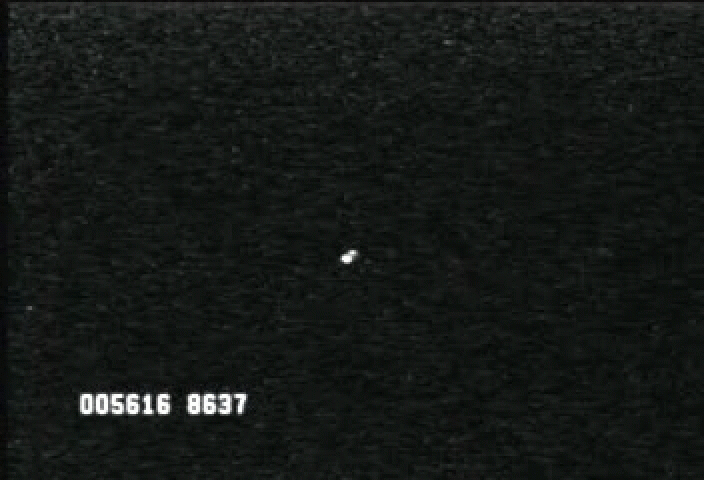
On UT 2007 Apr 18, asteroid (411) Xanthe occulted the bright star iota Cancri. Many observers recorded this event: see David Dunham's summary of the observations. I did a little analysis of two video recordings which were kindly made available.
Richard Nugent recorded the event from Ormand, FL, and Don Loftus taped it from Gainesville, FL. Their sites were separated by only 1 km perpendicular to the track path, so one would expect them to observe very similar results.
Note that iota Cancri is a challenging target because it has two bright components. The brighter component, which I'll call "A" from now on, is about 33 arcseconds SE of its fainter companion "B", and about 1.8 magnitudes brighter in the V-band. It is the brighter "A" component which is occulted by the asteroid. With typical backyard equipment, these two stars will not be separated by a large distance in video images. I found it challenging to disentangle the light of the two stars, and to figure out how to place the aperture properly. You'll see that the photometry clearly has some systematic errors in it ...
The Nugent video consists of 465 frames, each 352 x 240 pixels. Here's an example, the first frame, expanded by a factor of 2 for clarity.

Note that the two components of iota Cancri are not well separated in this video. The two centroids are only about 3 pixels apart in each direction, while the FWHM is roughly 3 pixels itself. That means that light from one star will "bleed" into the measurement aperture of the other star. Moreover, as the "A" component is occulted, the relative amount of contamination from "B" will rise. It was very difficult to do the photometry properly, as you'll see in a moment.
I followed my usual procedure:
I decided that the 1.5-pixel radius yielded the best results, but I'll show the light curves using each of the three radii below. In each case, I'll use a linear scale in integrated light intensity.
However, before I show the results, a word of caution: I suspect that there may be some artifacts in the video recording which affect the timing of events. You'll note that the frames in the Nugent video have a timestamp, which is (I think) inserted by a McAfee unit. I did not inspect every frame, but I did look carefully at the stamp values and the photometry for the first twenty frames. The results are ... troubling.
frame index stamp value star A star B
---------------------------------------------------------------
0 5616 8637 1103 1355
1 8637 1106 1356
2 8971 1155 1361
3 9305 1244 1398
4 9972 1191 1364
5 5617 304 1208 1367
6 304 1208 1367
7 304 1208 1367
8 1305 1134 1437
9 1639 1145 1374
10 1972 1206 1408
11 2640 1219 1402
12 2640 1245 1414
13 2974 1286 1420
14 3307 1331 1458
15 3641 1082 1418
16 3975 1090 1408
17 4308 1363 1453
18 4308 1335 1438
19 4976 1321 1479
---------------------------------------------------------------
Richard Nugent sent me E-mail which explained why some (or all?) of these issues arise:
I think the problem with the frame dropping and duplicate frames is my DVR. Its a Supercircuits model MDVR-10 and upon initial examination it appears to be ideal for occultation videos - records directly to a Compact Flash card, has a 2.5" screen, plays back frame by frame, and has a built in speaker. I wrote a review when I bought it here: http://www.weblore.com/richard/mdvr-10.htmHowever, upon actual use in the field withthe McAfee time inserter, I found that it records only 25 fps vs. the 30 fps advertised and the frames dropped are random, so the 5 dropped frames/sec don't fall out every 0.2 sec, they can drop out anywhere.
Also I suspect that the recording takes some processor time within the unit and thats why certain frames are lagging and have the same values. Hopefully as the technology improves, small DVR's like this one won;t have any processing delays. But in the meantime, its still gives great D and R times.
So, I don't really know the extent to which the photometric record is compromised. The entire video file has 465 frames, and the difference between the last (5631 8119) and first (5616 8637) timestamp is, if I interpret the stamps correctly, 14.9482 seconds; thus, the average frame rate is 31.0 frames per second.
Sigh. Perhaps someone else can figure this out. Keep all this in mind while you examine the photometry below.
First, using a 1.5-pixel aperture,
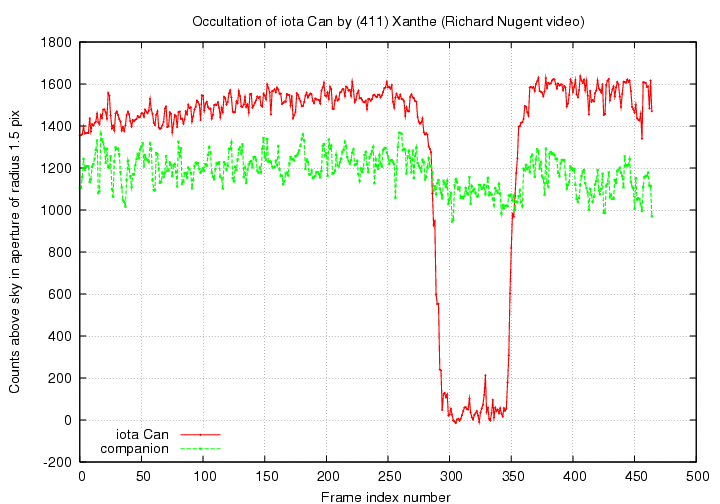
Note how the light of the "B" component appears to drop during the occultation. That's a consequence of the contamination of its measurement by light from "A". You'll see that this contamination grows as I use larger apertures ...
Next, using a 2-pixel aperture,
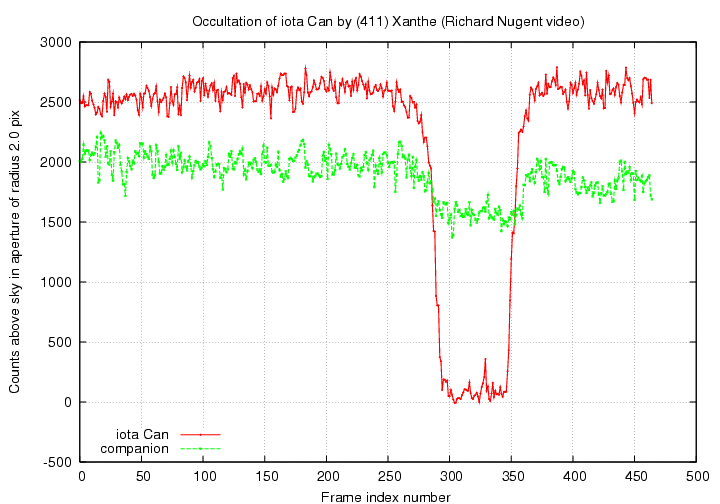
Finally, using a 2.5-pixel aperture,
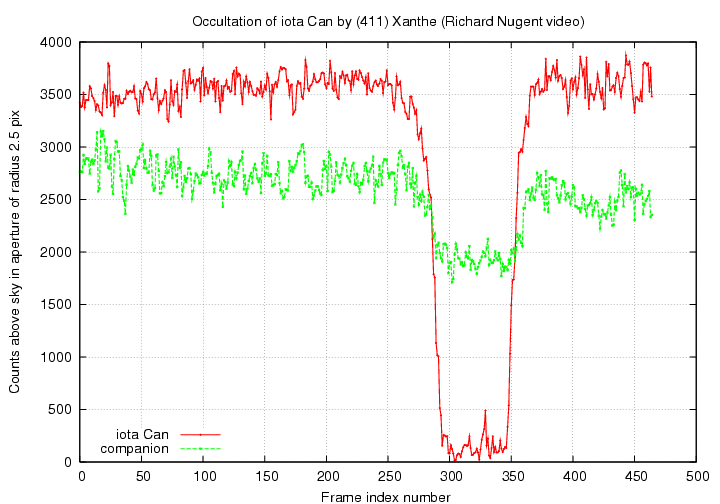
Now let's look at a closeup of the event star. I'll pick the 1.5-pixel aperture, and zoom in on the frames around the occultation.
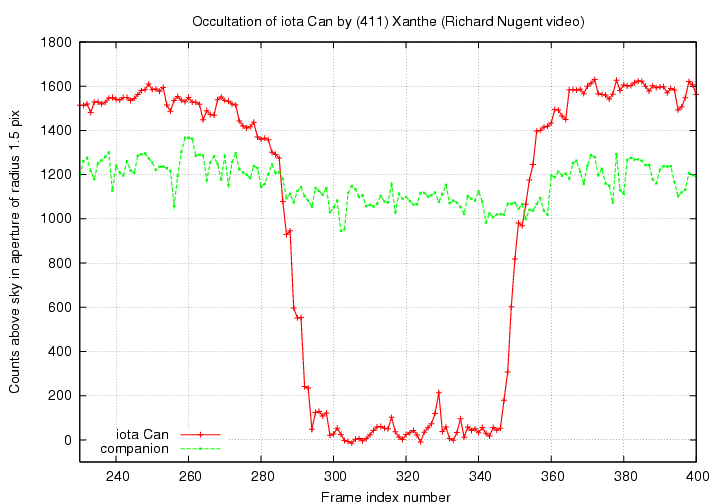
Both the D and R are extended, due to the large angular extent of the target star. Iota Cancri A is a G8Iab: star at a distance of about 90 parsecs (parallax 10.94 +/- 1.35 milliarcsec, from Hipparcos) with an angular size of about 2.2 +/- 0.2 milliarcsec ( from the CHARM2 catalog). The motion of (411) Xanthe as it passed the star was roughly 15.2 arcsec per hour (thanks to the JPL Horizons ephemeris system ), or 4.22 milliarcsec per second. We would expect the time for the leading edge of the asteroid to move across the uniform disk of the star to be about
ang size of disk 2.2 mas
ingress duration = ----------------- = ------------- = 0.52 sec
ang speed of edge 4.22 mas/sec
In other words, we would expect ingress (and egress) to last around 15 video frames. And that's just about what we see. Fine.
Is it possible to see effects due to the diffraction of light by the edge of the asteroid? I think not, both because the signal-to-noise is not great, and because the disk is well resolved, AND due to the uncertainties in photometry due to dropped and/or duplicated frames.
Col quantity
----------------------------------------------------------------------
1 coadded frame index
2, 4, 6 counts above sky for companion star B in aper radius 1.5, 2.0, 2.5
14, 16, 18 counts above sky for target star A in aper radius 1.5, 2.0, 2.5
----------------------------------------------------------------------
The second video I analyzed came from Don Loftus. The good news was that the two stars are better resolved, as this sample frame shows:
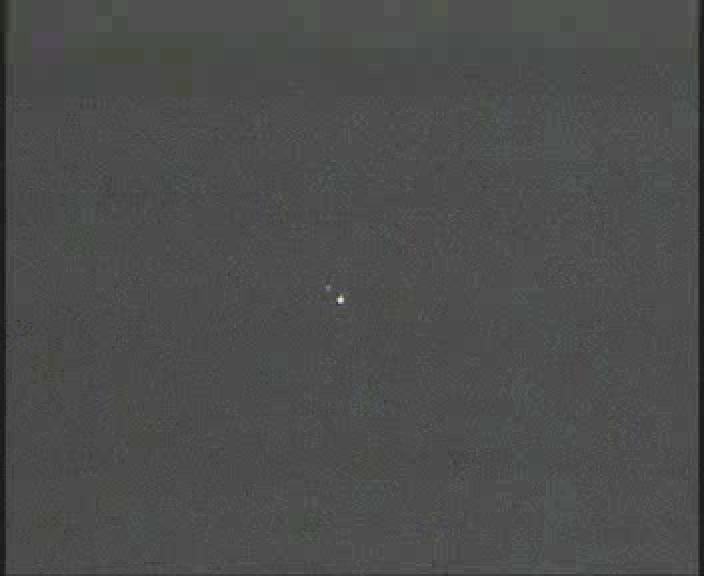
The bad news was that the positions of the stars varied quite a bit from frame to frame, due to (I am guessing) small vibrations in the mount or telescope tube and/or seeing. It was very difficult for me to come up with a scheme for placing apertures at the location of the two stars reliably: the fainter star wasn't always easy to see above the noise, so when the target component "A" disappeared, it wasn't always clear where the centroids were in a particular frame. After several hours of trying to come up with an automated scheme, I finally gave up and placed the apertures by hand for several hundred frames around the occulation.
Most of the processing was identical to that described above, except that I used mplayer to chop the video into frames, and I tried synthetic apertures of 2, 3, and 4 pixels.
Below is the photometry with aperture of radius 3 pixels, which seemed the best choice to me. Here are all the measurements I made ...
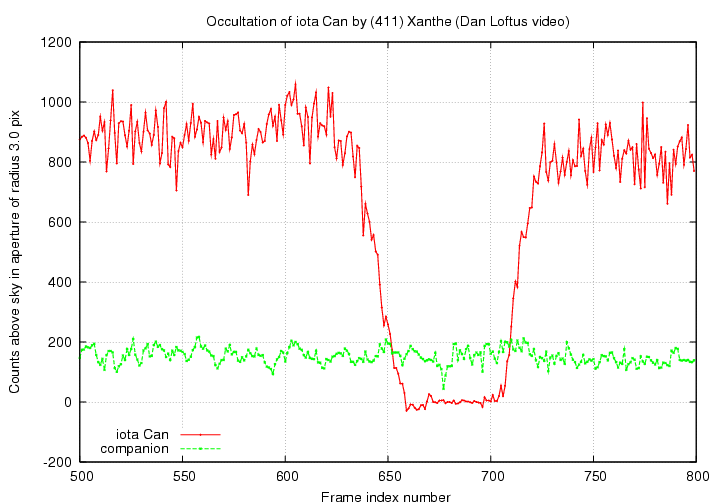
... and here's a closeup around the occultation itself.
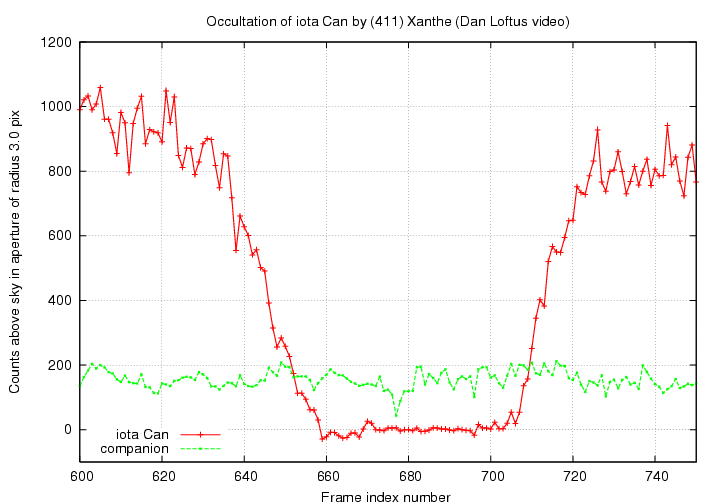
Both ingress and egress are gradual, taking place over roughly 15-20 frames, just as in the Loftus video. Good.
As before, you can examine my photometric data for yourself.
Col quantity
----------------------------------------------------------------------
1 coadded frame index
2, 4, 6 counts above sky for companion star B in aper radius 1.5, 2.0, 2.5
14, 16, 18 counts above sky for target star A in aper radius 1.5, 2.0, 2.5
----------------------------------------------------------------------